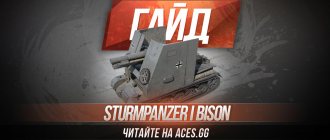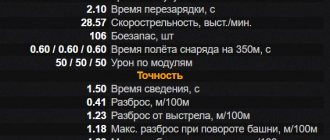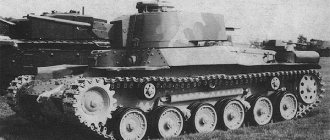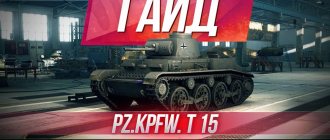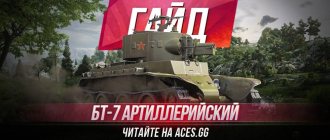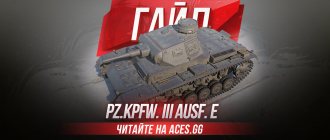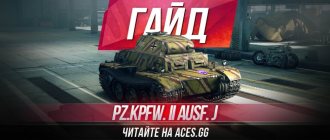Hello everyone who likes to look down on the battlefield, aces.gg is here! Tankers, as you might have already guessed, now we will talk about a representative of a class of equipment that is hated by many, the American Art-SPG of the third level - this is the M7 Priest guide
.
I would like to say right away that this device is quite standard artillery, of which there are many in our favorite game. At the same time M7 Priest World of Tanks
It’s quite possible to call her a really strong representative of her “kind”; she is very dangerous in battle, but to realize her potential, you need to have some knowledge.
Tactics
Tactics for the M7 Priest are not much different from combat tactics for any other low-level artillery. It doesn’t have the worst dynamics, which will allow the “priest” to occupy starting art positions and help the team (fortunately, the firing range of our top gun is very good). Good UGNs (horizontal aiming angles) are also very helpful, which make it easier to “lead” the enemy to shoot ahead, and also reduce our chances of being noticed by the enemy (the vehicle moves less + the bonus from the camouflage network is constantly working). In all other respects, this is the most ordinary Art-SPG, with its pros and cons. The main thing is to think about what you are doing and luck on the battlefields will be with you!
105mm Howitzer Motor Carriage M7 105mm self-propelled gun M7 Priest
M7 HMC Priest (SAU M7 Priest) One of the first self-propelled guns was delivered to the British in Egypt for empty testing, after which it was transferred back.
click the image and see the gallery
In June 1941, the American Army came up with the idea of installing a 105mm howitzer on the chassis of the M3 medium tank to accompany tank divisions. In October 1941, the Directorate of Armored Forces recommended the production of two pilot vehicles designated T32, and approval was received in November. Within a month, Baldwin Locomotive produced two T32 pilots. The cars had an M3 chassis with a modified top. As a result of tests at the Aberdeen Proving Ground, some changes were made to the design of the T32, the most noticeable of which was a kind of scaffolding for the crew at the gun. This superstructure resembled a church pulpit from which a priest preaches, which is why the car was called Priest. This Priest preached with a 105mm M1A2 howitzer, shifted to the right in the body. The top of the car was open.
In February 1942 the T32 was standardized as the M7 HMC. Serial production began at American Locomotive Co. in April 1942. By the end of the year, 2028 M7s were produced. However, production was hectic; it started and stopped several times due to changing requirements for this self-propelled gun.
Production vehicles differed from pilots in the presence of a commander's cupola, frontal shields and a turret for an anti-aircraft machine gun.
Later M7s had the support rollers from the M4, and several cars had a single molded frontal part, instead of the old three components connected by bots.
M7B2 HMC Priest (self-propelled gun М7В2 Priest)
click the image and see the gallery
In September 1943, it was decided to switch from the outdated M3 tank chassis to the newer M4A3 medium tank chassis. This modification was named M7B1. The M7B1 differed from the previous version by the presence of side armored screens and a single cast nose piece, which replaced three parts connected by bolts. From March 1944 to February 1945, Pressed Steel Corporation produced 826 machines. Later, Federal Welder joined production, producing 127 units of M7 and M7B1 until the end of WW2.
In January 1945, the American Army standardized the M37 HMC self-propelled gun on the M24 chassis. As a result, the M7 and M7B1 self-propelled guns were reclassified as a “substitute standard” and were gradually withdrawn from service.
At one time, England showed interest in the M7. In March 1942, the British tank mission in the United States ordered 2,500 M7s, which were to be delivered to the British by the end of 1942. Another 3,000 M7s were to arrive before the end of 1943. However, since the Americans themselves needed these self-propelled guns, this contract was never completed in full completed. The British received the first 90 M7 self-propelled guns in September 1942. Due to the fact that the British were facing a serious situation in Egypt, instead of the American army, these M7s were sent to the British 8th Army. This supply came in very handy and played a big role in the second battle of El Alamein. In British service, the M7 Priest self-propelled guns received the designation “105mm SP, Priest” and were supplied to artillery battalions of tank divisions. As part of the 8th Army, the M7 Priest self-propelled gun then fought in Italy. During the Battle of Normandy, the British lost interest in the M7. A few days after the landing, the 21st Army Group chose the Sexton self-propelled guns. The abandonment of the M7 was partly due to the desire to unify the supply of ammunition. The British converted the M7, which had been withdrawn from service, into the Kangaroo APC.
During the Korean War, the M7s were again in demand, although in a modified version. At the maximum vertical pointing angle, the M7 self-propelled gun fired at 10,400 yards and could not fire at the reverse slopes of the hills and mountains that abound in Korea. To solve the problem, a modification of the M7B2 was developed, in which the gun was mounted 18 inches higher, which made it possible to increase the vertical angle to 65 degrees.
M7, M7B1 and M7B2 entered the artillery battalions of tank divisions.
M7 HMC Priest (SAU M7 Priest) - top rear view.
click the image and see the gallery
| 105mm Howitzers M2A1 and M4 105 mm howitzers M2A1 and M4 | ||
| accommodation | Motor Carriage M7 and M7B1 on an M5 carriage (M2A1 howitzer) | |
| chamber length (without rifling) | 15.03 inches | |
| threaded length | 78.02 inches | |
| chamber length (to the edge of the projectile) | 11.38 inches | |
| channel length | 81.67 inches | |
| barrel length | 93.05 inches, 22.5 gauge | |
| shutter release length | 8.3 inches (M2A1 howitzer), 8.25 inches (M4 howitzer) | |
| length from the barrel to the back of the bolt | 101.35 inches, 24.5 caliber (M2A1 howitzer) 101.3 inches, 24.5 caliber (M4 howitzer) | |
| extra length, with bolt mechanism | No | |
| total length | 101.35 inches (M+2A-1 howitzer), 101.3 inches (M4 howitzer) | |
| channel diameter | 4.134 inches | |
| chamber volume | 153.8 cu. inches | |
| total howitzer weight | 1,080 lbs (M2A1 howitzer), 1,410 lbs (M4 howitzer) | |
| shutter type | horizontal wedge valve | |
| rifling | 36 rifling, right hand, 1 turn/20 gauge | |
| ammunition | separate charging, variable charge, except HEAT M67 | |
| fuse | impact type | |
| total ammunition weight | HE M1 Shell (HE) - 42 lbs HEAT M67 Shell (HEAT-T) - 36.85 lbs WP M60 Shell, Smoke - 43.77 lbs HC BE M60 Shell, Smoke - 41.94 lbs | |
| projectile weight | HE M1 Shell (HE) - 33 lbs HEAT M67 Shell (HEAT-T) - 29.22 lbs WP M60 Shell, Smoke - 34.31 lbs HC BE M60 Shell, Smoke - 32.87 lbs | |
| highest pressure of powder gases | 28,000 psi | |
| highest rate of fire | 8 shots/min | |
| starting speed | HE M1 Shell (HE) - 1550 ft/s HEAT M67 Shell (HEAT-T) - 1250 ft/s WP M60 Shell, Smoke - 1550 ft/s HC BE M60 Shell, Smoke - 1550 ft/s | |
| muzzle energy of the projectile, KE= 1/2 MV2 | HE M1 Shell (HE) - 555 ft-tons HEAT M67 Shell (HEAT-T) - 317 ft-tons | |
| firing range | HE M1 Shell (HE) - 12205 yards HEAT M67 Shell (HEAT-T) - 8590 yards WP M60 Shell, Smoke - 12150 yards HC BE M60 Shell, Smoke - 12205 yards | |
| HE M1 Shell (HE) - high explosive HEAT M67 Shell (HEAT-T) - cumulative, tracer WP M60 Shell, Smoke - smoke HC BE M60 Shell, Smoke - smoke | ||
| armor penetration of 105 mm M2A1 and M4 howitzers against homogeneous armor at an angle of 30 degrees | ||||||||
| projectile type | Name | weight, pounds | initial speed, feet/sec | range, m | ||||
| any | ||||||||
| cumulative, tracer | HEAT M67 Shell (HEAT-T) | 29.22 | 1250 | 4 inches | ||||
M7 Priest modifications
25pdr Howitzer Motor Carriage T51
Since the British decided to purchase American M7s, an attempt was made at the Aberdeen Proving Ground to bring the vehicle into maximum compliance with English requirements. In July 1942, a British 25-pound howitzer was experimentally installed on a standard M7. This self-propelled gun remained experimental and did not make it into series.
Priest Kangaroo
In Nrmandia, the British considered their M7s to be quite unsuitable and abandoned them in favor of the Sexton self-propelled guns. In order to use decommissioned self-propelled guns to the greatest benefit, it was decided to convert these self-propelled guns into armored personnel carriers. In the field, the M7 self-propelled guns were dismantled with weapons and ammunition, and the frontal hole after the howitzer was covered with armor. The result of this modernization was the Priest Kangaroo armored personnel carrier, capable of transporting 20 infantrymen with two crew members (commander and driver). Between October 1944 and April 1945, 102 vehicles were converted to Priest Kangaroo. It was a pretty good idea to recycle obsolete self-propelled guns into armored personnel carriers. Back in Italy, the 8th Army created an entire regiment equipped with such APCs based on obsolete Sherman tanks.
Priest OP
In 1944, an English modification of the Priest appeared, adapted for artillery spotters. The weapons were removed from the linear vehicle and additional means of communication were installed - radio stations, field telephones and reels of telephone wires. Externally, Priest OP was practically no different from Priest Kangaroo.
topic navigation
M7 HMC - gallery M7 HMC - camouflage M7 HMC - gallery Para Bellum
sources
Peter Chamberlen and Chris Ellis - British and American Tanks of World War Two - Silverdale Books, 2004
Robert J. Icks - Hellcat, Long Tom and Priest - AFV/Weapons Profiles, No26
Hunnicutt, R.P. - Sherman. A History of the American Medium Tank - Presidio Press, 1994
Optional equipment
As with any other artillery, it is mandatory for us to improve aiming and reloading - “drives” and “rammer” must-haves. Also, given our excellent horizontal aiming angles, it would not be a bad idea to install a camouflage net - most of the time the bonus from it will be active. Equipment prices are listed below:
- “Reinforced aiming drives” - 500,000 silver
- “Medium caliber howitzer rammer” – 200,000 silver
- “Camouflage net” – 100,000 silver
Notes[edit]
- Tracol, Xavier (October 2011). "Blindorama: Argentina 1926–1945." Batailles et Blindés
(in French). No. 45. Caraktère. pp. 4–7. ISSN 1765-0828. - "The Rearmament of Austria: Weapons of the Second World War". wwiiafterwwii.wordpress.com
. June 14, 2015. - Kočevar, Iztok (August 2014). "Micmac à tire-larigot chez Tito: L'arme blindée yougoslave durant la Guerre froide" [The Yugoslav Armored Arm during the Cold War]. Batailles et Blindés
(in French). No. 62. Caraktère. pp. 66–79. ISSN 1765-0828. - ^ B s d e g Zaloga, Stephen J. (2013). M7 Priest 105mm HMC
.
Oxford, UK: Osprey Publishing. p. [ page required
]. ISBN 978-1-78096-023-4. - ^ abc Icks, AFV No. 26
- ^ ab Bishop, page 120.
- Icks, R. AFV Profile 26 - Hellcat, Long Tom and the Priest
- ^ ab Chamberlain and Ellis British and American tanks of the Second World War
1969 p. 138 - ^ abc Norris, John (2012) Tanks and Trucks of World War II The History Press. ISBN 0-75249-073-7
- ^ ab Bishop, page 121.
- Jump up
↑ John Keegan,
Six Armies in Normandy
, The Viking Press, New York, 1982, pp. 126–27 - ↑ Advanced Squad Leader
, British Vehicle Notes, The Avalon Hill Game Co., Baltimore, MD, 1988, p. H61 - Collins, Michael. King, Martin. Voices of the Bulge: Untold Stories from Veterans of the Battle of the Bulge
. MBI Publishing Company, 2011. p. 193 - Gourley, Scott R. "The Korean War's Land Battle Legacy". Defense Media Network
. Retrieved March 30, 2016. - Collateral, Steven J. (2013). M7 Priest 105 mm howitzer. Osperey Publishing. paragraph 45. ISBN 978-1-78096-025-8. Retrieved March 31, 2016.
- Usher, Dani (2014). Inside Israel's Northern Command: The Yom Kippur War on the Syrian Border (USA ed., 2016). Lexington, KY: University of Kentucky Press. ISBN 978-0-8131-6766-4. Retrieved March 31, 2016.
- Ken Tout, A Fine Night for Tanks - The Road to Falaise
, Sutton Publishing Ltd., Stroud, Gloucestershire, UK, 1998, pp. 40 - 41 - ↑ Advanced Squad Leader
, British Vehicle Notes, The Avalon Hill Game Co., Baltimore, MD, 1988, p. H63 - Jones, Richard. Tanks
. Zenith Imprint, 2004. P.44. - Chamberlain and Ellis, p139
Crew Perks
I don’t think that at level 3 you will level up more than 1 - 2 perks completely, but still:
Commander
- The Brotherhood of War
- Sixth Sense
- Disguise
Gunner
- The Brotherhood of War
- Disguise
- Smooth rotation of the tower
Driver mechanic
- The Brotherhood of War
- Disguise
- Virtuoso
Radio operator
- The Brotherhood of War
- Disguise
- Radio interception
Charging
- The Brotherhood of War
- Disguise
- Optional
Charging
- The Brotherhood of War
- Disguise
- Optional
As with most "arts", the main skills for us are camouflage, sixth sense and military brotherhood. The remaining, secondary skills will slightly improve our combat effectiveness.
Links[edit]
- Doyle, David. Standard catalog of US military equipment. Krause Publications, 2003
- Bishop, Chris. Encyclopedia of weapons of the Second World War. Sterling Publishing Company, Inc., 2002.
- Collins, Michael. King, Martin. Voices of the Bulge: Untold Stories from Veterans of the Battle of the Bulge. MBI Publishing, 2011
- Jones, Richard. Tanks. Zenith Imprint, 2004
- TM 9-2800 Standard military equipment. dated September 1, 1943
- TM 9-731E
- TM 9-1725
- TM 9-1750A
- TM 9-1750B
- TM 9-1750S
- TM 9-1750D
- TM 9-1750K
- TM 9-1751
- TM 9-1825A
- TM 9-1825B
